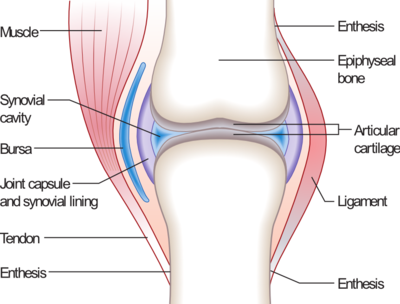Synovial joint: Difference between revisions
m WP:CHECKWIKI error fixes + genfixes using AWB (7218) |
|||
| Line 8: | Line 8: | ||
* [[articular cartilage]]: lines the epiphyses of joint end of bone. Provides the loading and unloading mechanism to resist load and shock |
* [[articular cartilage]]: lines the epiphyses of joint end of bone. Provides the loading and unloading mechanism to resist load and shock |
||
* [[synovial membrane]]: the inner layer of the fibrous [[articular capsule]]. The [[synovial membrane]] covers the lining of the synovial cavity where [[articular cartilage]] is absent. |
* [[synovial membrane]]: the inner layer of the fibrous [[articular capsule]]. The [[synovial membrane]] covers the lining of the synovial cavity where [[articular cartilage]] is absent. |
||
yes it is |
|||
==Nerve Supply of Synovial Joint== |
==Nerve Supply of Synovial Joint== |
||
Revision as of 12:32, 8 October 2010

A Synovial joint, also known as a diarthrosis, is the most common and most movable type of joint in the body of a mammal. As with most other joints, synovial joints achieve movement at the point of contact of the articulating bones.
Structural and functional differences distinguish synovial joints from cartilaginous joints (synchondroses and symphyses) and fibrous joints (sutures, gomphoses, and syndesmoses). The main structural differences between synovial and fibrous joints is the existence of capsules surrounding the articulating surfaces of a synovial joint and the presence of lubricating synovial fluid within that capsule (synovial cavity).
Structure
- articular capsule: The fibrous capsule is continuous with the periosteum of bone. It is also highly innervated but avascular (lacking blood and lymph vessels)
- articular cartilage: lines the epiphyses of joint end of bone. Provides the loading and unloading mechanism to resist load and shock
- synovial membrane: the inner layer of the fibrous articular capsule. The synovial membrane covers the lining of the synovial cavity where articular cartilage is absent.
yes it is
Nerve Supply of Synovial Joint
It is derived from the nerve supply of muscles acting on the joint.
Blood Supply of Synovial Joint
From the arteries sharing in the anastomosis around the joint.
Movements possible
The movements possible with synovial joints are:
- Abduction: movement away from the mid-line of the body.
- Adduction: movement towards the mid-line of the body.
- Extension: straightening limbs at a joint.
- Flexion: bending the limbs at a joint.
- Rotation: a circular movement around a fixed point.
Types
There are seven types of synovial joints. Some are relatively immobile, but are more stable. Others have multiple degrees of freedom, but at the expense of greater risk of injury. In ascending order of mobility, they are:[1]
| Name | Example | Description |
|---|---|---|
| Gliding joints (or planar joints) | the carpals of the wrist, acromioclavicular joint | These joints allow only gliding or sliding movements. |
| Hinge joints | the elbow (between the humerus and the ulna) | These joints act like a door hinge, allowing flexion and extension in just one plane. |
| Pivot joints | Atlanto-axial joint, proximal radioulnar joint, and distal radioulnar joint | One bone rotates about another. |
| Condyloid joints (or ellipsoidal joints) | the wrist joint (radiocarpal joint) | A condyloid joint is where two bones fit together with an odd shape (e.g. an ellipse), and one bone is concave, the other convex. Some classifications make a distinction between condyloid and ellipsoid joints. |
| Saddle joints | Carpometacarpal or Trapeziometacarpal Joint of thumb (between the metacarpal and carpal - the trapezium ) , sternoclavicular joint | Saddle joints, which resemble a saddle, permit the same movements as the condyloid joints. |
| Ball and socket joints | the shoulder(glenohumeral), and hip joints | These allow a wide range of movement. |
| Compound joints | the knee joint | condylar joint(condyles of femur join with condyles of tibia) and saddle joint(lower end of femur joins with patela). |
Factors Influencing Joint Stability
- The shape of articular surfaces.
- capsule & ligaments.
- Muscle Tone.
- gravity
- Atmospheric Pressure.
References
